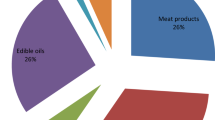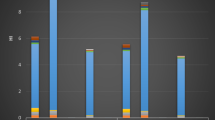Abstract
Background
Chlorine-based disinfectants are often used to sanitize fruit and vegetables to produce a product called ready-to-eat (RTE) vegetables. During the disinfection process, disinfection byproducts (DBPs), such as trihalomethanes (THMs) and haloacetic acids (HAAs), might be formed via chlorination.
Objective
To determine the amounts of DBPs that occur in RTE vegetables in Taiwan, an analytical method which can detect THMs and HAAs simultaneously was developed for this study.
Methods
For HAAs, dimethyl sulfate (DMS) was first added into the sample as derivatization reagent and tetrabutylammonium hydrogen sulfate (TBA-H2SO4) was used as the ion-pairing agent to improve the derivatization process. Afterwards, the solid-phase microextraction (SPME) procedure coupled with gas chromatography with tandem mass spectrometers (GC/MS/MS) was performed to measure the HAAs derivatives and THMs in the sample.
Results
A total of 92 single RTE ingredients were analyzed in this study. Among various THMs and HAAs, the results showed that dibromochloromethane (21%) and dichloroacetic acid (12%) had the highest detection rates, respectively. Compared with fruits, vegetables were more easily to contain DBPs. For adults in Taiwan, the maximum daily exposure of THMs and HAAs estimated via the consumption of RTE vegetables were 28.53 and 77.83 μg, respectively.
Significance
The findings from this study suggest that the exposure of DBPs from RTE vegetables is an important food safety issue in Taiwan.
This is a preview of subscription content, access via your institution
Access options
Subscribe to this journal
Receive 6 print issues and online access
$259.00 per year
only $43.17 per issue
Buy this article
- Purchase on Springer Link
- Instant access to full article PDF
Prices may be subject to local taxes which are calculated during checkout


Similar content being viewed by others
Data availability
All data generated or analysed during this study are included in this published article and its supplementary information file.
References
Ramos B, Miller FA, Brandão TRS, Teixeira P, Silva CLM. Fresh fruits and vegetables—An overview on applied methodologies to improve its quality and safety. Innov Food Sci Emerg Technol 2013;20:1–15.
Lamikanra O. Fresh-cut fruits and vegetables: science, technology, and market. 1st edition, CRC Press, Boca Raton, Florida, 2002.
Gallego M, and Cardador MJ. Regulated disinfection byproducts in minimally processed vegetables and beverages. In: Food Hygiene and Toxicology in Ready-to-Eat Foods, pp. 417–38. Academic Press, Cambridge, Massachusetts, 2016.
Betts G, Everis L. Alternatives to hypochlorite washing systems for the decontamination of fresh fruit and vegetables. In book: Improving the Safety of Fresh Fruit and Vegetables, W. Jongen, ed., Woodhead Publishing, pp. 351-72, 2005.
Richardson SD, Ternes TA. Water analysis: emerging contaminants and current issues. Anal Chem 2011;83:4614–48.
Krasner SW, Weinberg HS, Richardson SD, Pastor SJ, Chinn R, Sclimenti MJ, et al. Occurrence of a New Generation of Disinfection Byproducts. Environ Sci Technol 2006;40:7175–85.
IARC. Chlorinated drinking-water; chlorination by-products; some other halogenatetd compounds; cobalt and cobalt compounds. Lyon, International Agency for Research on Cancer, pp. 45–359, 1991 (IARC Monographs on the Evaluation of Carcinogenic Risks to Humans, 52).
World Health Organization. Trihalomethanes in drinking-water, background document for development of WHO Guidelines for Drinking-water Quality. WHO/SDE/WSH/05.08/64, Geneva, Switzerland, 2005.
World Health Organization. Guidelines for drinking-water quality, fourth edition incorporating the first addendum, Geneva, Switzerland, 2017.
Coroneo V, Carraro V, Marras B, Marrucci A, Succa S, Meloni B, et al. Presence of Trihalomethanes in ready-to-eat vegetables disinfected with chlorine. Food Addit Contam Part A. 2017;34:2111–7.
Cardador MJ, Gallego M. Effect of the chlorinated washing of minimally processed vegetables on the generation of haloacetic acids. J Agr Food Chem 2012;60:7326–32.
Chang FYH, Dawson J. The acceptance and adaptation of a foreign retail format: the case of the convenience store in Taiwan in the 1980s and 1990s. Int J Entrep 2007;4:17–40.
Sun YM, Wang ST, Huang KW. Hygiene knowledge and practices of night market food vendors in Tainan City, Taiwan. Food Control. 2012;23:159–64.
US Environmental Protection Agency (US EPA). Determination of Carbonyl Compounds in Drinking Water by Pentafluorobenzyl hydroxylamine Derivatization and Capillary Gas Chromatography with Electron Capture Detection. Office of Research and Development, US EPA Method 556, Cincinnati, OH, 1998.
Taiwan Food and Drug Administration (Taiwan FDA). National Food Consumption Database. https://tnfcds.nhri.edu.tw/.
Taiwan Food and Drug Administration (Taiwan FDA). Hygienic Guides to the Production of Fresh-Cut Vegetables and Fruits, 2016.
Chang HH, Tung HH, Chao CC, Wang GS. Occurrence of haloacetic acid (HAAs) and trihalomethanes (THMs) in drinking water of Taiwan. Environ. Moni Assess 2010;162:237–50.
Gómez-López VM, Marín A, Medina-Martínez MS, Gil MI, Allende A. Generation of trihalomethanes with chlorine-based sanitizers and impact on microbial, nutritional and sensory quality of baby spinach. Postharvest Biol Tec 2013;85:210–7.
Funding
This study was supported by a grant from the Ministry of Science and Technology (MOST108-2314-B-002-139-MY3), Executive Yuan, Taiwan.
Author information
Authors and Affiliations
Contributions
Both of A-HL and S-WT contributed to the design and implementation of the research, to the analysis of the results and to the writing of the manuscript.
Corresponding author
Ethics declarations
Competing interests
The authors declare no competing interests.
Additional information
Publisher’s note Springer Nature remains neutral with regard to jurisdictional claims in published maps and institutional affiliations.
Supplenmentary information
Rights and permissions
Springer Nature or its licensor holds exclusive rights to this article under a publishing agreement with the author(s) or other rightsholder(s); author self-archiving of the accepted manuscript version of this article is solely governed by the terms of such publishing agreement and applicable law.
About this article
Cite this article
Lin, AH., Tsai, SW. Dietary intakes of trihalomethanes and haloacetic acids from ready-to-eat vegetables in taiwan. J Expo Sci Environ Epidemiol 33, 824–830 (2023). https://doi.org/10.1038/s41370-022-00465-2
Received:
Revised:
Accepted:
Published:
Issue Date:
DOI: https://doi.org/10.1038/s41370-022-00465-2



